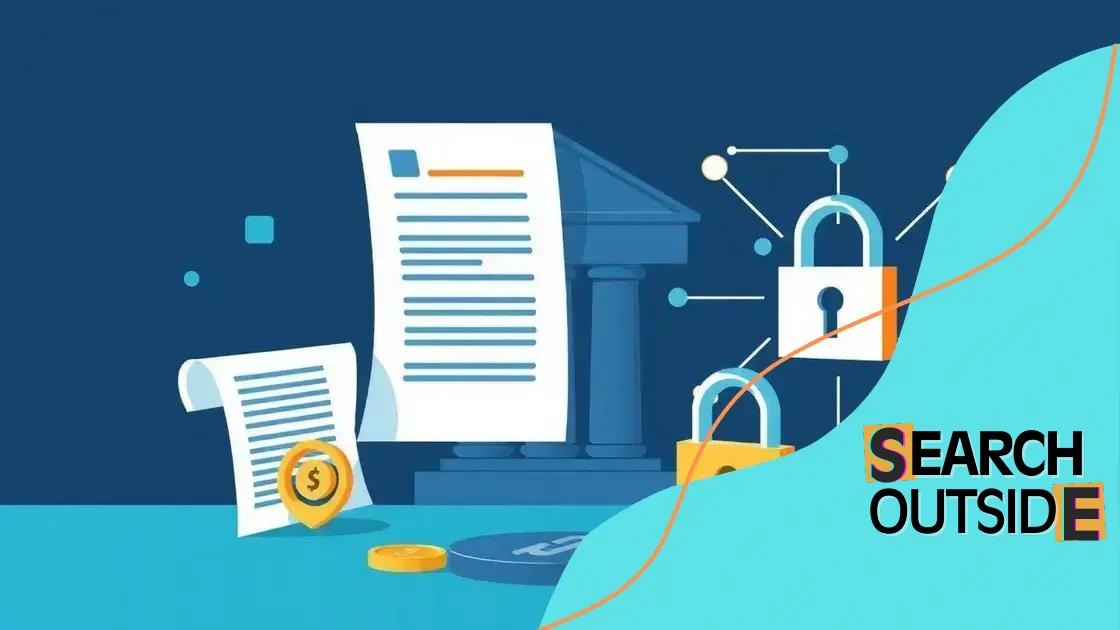The influence of blockchain on modern banking systems

The influence of blockchain on modern banking systems enhances security, improves transaction efficiency, and enables innovative financial solutions while addressing regulatory and integration challenges.
The influence of blockchain on modern banking systems is reshaping how banks operate. Curious about how this technology enhances security and efficiency? Let’s dive into it.
Understanding blockchain technology
Understanding blockchain technology is crucial for grasping its impact on various industries, especially banking. Blockchain is a decentralized, digital ledger that records transactions across many computers. This technology ensures that transactions can’t be altered retroactively, which enhances security and trust, making it ideal for financial services.
What is Blockchain?
At its core, blockchain consists of a chain of blocks, each containing data. These blocks are linked and secured using cryptography. This creates a tamper-proof record, allowing users to verify transactions without needing a central authority.
Key Features of Blockchain
- Decentralization: No single point of control, reducing risks of manipulation.
- Transparency: All transactions are visible to participants, promoting accountability.
- Security: Cryptographic techniques protect data integrity.
- Immutability: Once recorded, data in a block cannot be changed.
The adoption of blockchain in finance addresses various challenges faced by traditional banking, such as fraud and inefficiencies. Banks can process transactions faster and cheaper, which can lead to better customer experiences. This technology has the potential to revolutionize payment processing, lending, and even identity verification.
Moreover, blockchain’s smart contracts automate agreements, ensuring they execute when conditions are met. This reduces the need for intermediaries, making processes more efficient and cost-effective. As such, understanding how blockchain functions will help investors and consumers navigate the evolving banking landscape.
Key benefits of blockchain in banking
The key benefits of blockchain in banking are transforming how financial institutions operate. This innovative technology enhances security, promotes efficiency, and reduces costs.
Improved Security
One major advantage of blockchain is its enhanced security features. Transactions are encrypted and recorded across a distributed network. This reduces the risk of fraud and unauthorized access, making it harder for cybercriminals to attack financial data.
Increased Transparency
Blockchain technology provides a transparent record of all transactions. Participants in the network can verify transactions independently. This transparency builds trust among customers and reduces disputes.
Cost Reduction
Another significant benefit is the reduction of transaction costs. By eliminating intermediaries, such as banks and payment processors, blockchain allows for direct peer-to-peer transactions. These savings can lead to lower fees for consumers and businesses.
- Faster Transactions: Transactions are processed in real-time or near real-time, significantly speeding up fund transfers.
- 24/7 Availability: Blockchain operates continuously, allowing transactions to occur at any time without downtime.
- Global Reach: Blockchain can facilitate international transactions easily, broadening access to banking services.
- Automated Processes: Smart contracts automate processes like loan approvals, reducing errors and delays.
Financial institutions are increasingly adopting blockchain to capitalize on these benefits. As banks integrate this technology, they can enhance customer experiences, streamline operations, and remain competitive in a rapidly evolving market. With the growing interest in cryptocurrency, the need for reliable blockchain solutions has never been more relevant.
Challenges of integrating blockchain systems

The challenges of integrating blockchain systems in banking are significant, yet they offer opportunities for innovation. Understanding these obstacles can help financial institutions navigate the complexities involved in adopting this technology.
Regulatory Compliance
One of the main hurdles is regulatory compliance. Banks must adhere to existing financial regulations, which can be quite rigid. Blockchain’s decentralized nature may conflict with traditional regulatory frameworks, making it challenging for banks to implement.
Interoperability Issues
Another challenge is interoperability. Different blockchain networks may not communicate effectively with each other. This lack of standardization can create friction in transactions and make it harder for banks to integrate blockchain solutions with their existing systems.
Security Concerns
While blockchain offers enhanced security, it is not invulnerable. As banks integrate these systems, they must be vigilant about potential vulnerabilities that could be exploited. Regular security assessments and updates are crucial to safeguard against cyber threats.
- Technology Cost: Implementing blockchain solutions can be expensive, involving both hardware and software investments.
- Skill Gaps: Banks may face challenges in finding skilled professionals knowledgeable in blockchain technology.
- Cultural Resistance: Employees and leadership may resist changes to established practices, making it difficult to embrace new technologies.
Additionally, the technology is still evolving. Many banks are cautious about adopting a system that might change significantly over time. This uncertainty can lead to hesitation in full-scale implementation. As they face these challenges, banks must weigh the potential benefits of blockchain against the complexities of integration. With careful planning, they can overcome these obstacles and leverage this revolutionary technology to improve their operations.
Real-world examples of blockchain in banks
Real-world examples of blockchain in banks showcase how this technology is being utilized to revolutionize financial services. Several banks worldwide are experimenting with blockchain to improve efficiency and security in various operations.
RippleNet for Cross-Border Payments
One notable example is Ripple, which allows banks to use its blockchain network for cross-border payments. Transfers via RippleNet are faster and cheaper compared to traditional methods. This innovation enhances liquidity and improves transaction speed, benefiting both banks and their customers.
JPMorgan’s Blockchain Network
JPMorgan Chase has developed its own blockchain network called JP Morgan Coin. This digital currency facilitates instantaneous payments between clients, reducing the time and costs associated with traditional banking transactions. By using this system, JPMorgan enhances security while providing clients with faster transaction capabilities.
BBVA and Smart Contracts
Spanish bank BBVA has implemented blockchain technology to streamline its loan process. By using smart contracts, BBVA can automate transactions, reducing paperwork and increasing transparency. This approach simplifies the borrowing process for customers and cuts operational costs.
- Standard Chartered has used blockchain to digitize trade finance, making it easier to track transactions.
- Deutsche Bank invests in blockchain partnerships to explore applications in securities and asset management.
- HSBC employs blockchain technology to enhance the efficiency of its foreign exchange transactions.
These examples illustrate the growing acceptance of blockchain among leading financial institutions. As banks continue to explore and implement blockchain solutions, they can offer improved services and address long-standing challenges within the financial sector. With ongoing advancements, the potential applications of blockchain are likely to expand even further, making it a critical component of the modern banking landscape.
Future trends in banking with blockchain
The future trends in banking with blockchain are exciting and transformative. As technology evolves, banks are looking to integrate blockchain into their operations to enhance services and customer experiences.
Enhanced Customer Experience
One trend is the focus on enhancing customer experiences. Blockchain allows for faster transactions, which leads to instantaneous payments and transfers. Customers will benefit from improved efficiency and lower fees, creating a more user-friendly banking environment.
Increased Adoption of Decentralized Finance (DeFi)
Another significant trend is the rise of decentralized finance, or DeFi. This movement allows individuals to conduct financial transactions without traditional intermediaries, like banks. As DeFi grows, banks may adapt by offering services that integrate these technologies, potentially empowering customers to manage their finances more flexibly.
Regulatory Innovations
As blockchain in banking expands, we can expect innovations in regulatory frameworks as well. Regulators will work to create standards that facilitate blockchain adoption, ensuring consumer protection while encouraging innovation. These frameworks will help build trust in technology and promote its use across the industry.
- Artificial Intelligence Integration: The combination of AI and blockchain could lead to more personalized banking services.
- Cross-Industry Collaboration: Banks will collaborate with tech companies to develop innovative blockchain solutions.
- Focus on Sustainability: Blockchain can enhance transparency in sustainable practices, helping banks track and promote green initiatives.
As we look ahead, it is clear that the evolution of blockchain will continue to shape the future of banking. Financial institutions that embrace this technology will be better positioned to offer innovative solutions that meet the needs of their customers.
In conclusion, blockchain technology is changing the face of modern banking. By enhancing security, improving efficiency, and introducing innovative financial products, banks are better equipped to meet the needs of their customers. While challenges remain, such as regulatory compliance and integration issues, the benefits of blockchain are clear. As banks continue to navigate this evolving landscape, they will likely lead to a more secure and efficient financial environment for everyone.
\n\n
\n
FAQ – Frequently Asked Questions About Blockchain in Banking
What are the main benefits of blockchain in banking?
The main benefits include enhanced security, increased efficiency, lower transaction costs, and improved customer experiences.
What challenges do banks face when integrating blockchain?
Challenges include regulatory compliance issues, interoperability with existing systems, and the need for skilled personnel.
How is blockchain changing customer experiences in banking?
Blockchain enables faster transactions, lower fees, and more flexible financial products, significantly enhancing the overall customer experience.
What future trends can we expect with blockchain in banking?
Future trends include the rise of decentralized finance (DeFi), regulatory innovations, and increased collaboration between banks and technology firms.





